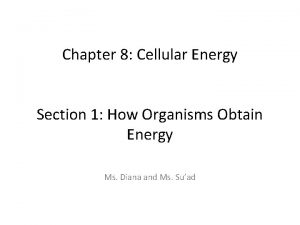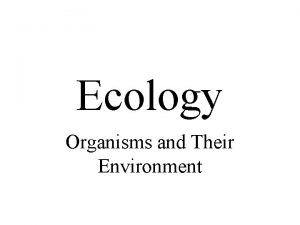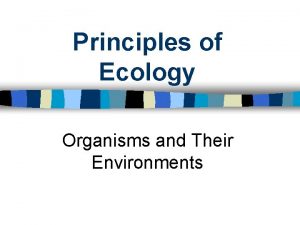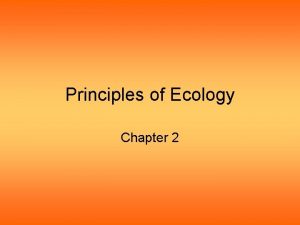Chapter 2 Principles of Ecology Section 1 Organisms













- Slides: 13


Chapter 2 Principles of Ecology Section 1: Organisms and Their Relationships Section 2: Flow of Energy in an Ecosystem Section 3: Cycling of Matter Click on a lesson name to select.

Chapter 2 Principles of Ecology 2. 1 Organisms and Their Relationships Ecology § Scientific discipline in which the relationships among living organisms and the interaction the organisms have with their environments are studied § Ecologists observe, experiment, and model using a variety of tools and methods.

Chapter 2 Principles of Ecology 2. 1 Organisms and Their Relationships The Biosphere § A thin layer around Earth § Extends several kilometers above the Earth’s surface § Extends several kilometers below the ocean’s surface

Chapter 2 Principles of Ecology 2. 1 Organisms and Their Relationships The Biosphere

Chapter 2 Principles of Ecology 2. 1 Organisms and Their Relationships Biotic Factors § Living factors in an organism’s environment Abiotic Factors § Nonliving factors in an organism’s environment § Organisms adapt to survive in the abiotic factors present in their natural environment.

Chapter 2 Principles of Ecology 2. 1 Organisms and Their Relationships Levels of Organization § Levels increase in complexity as the numbers and interactions between organisms increase. § organism § population § biological community § ecosystem § biome § biosphere

Chapter 2 Principles of Ecology 2. 1 Organisms and Their Relationships § The lowest level of organization is the individual organism itself. § Organisms of a single species that share the same geographic location at the same time make up a population. § A biological community is a group of interacting populations that occupy the same geographic area at the same time.

Chapter 2 Principles of Ecology 2. 1 Organisms and Their Relationships § An ecosystem is a biological community and all of the abiotic factors that affect it. § A biome is a large group of ecosystems that share the same climate and have similar types of communities.

Chapter 2 Principles of Ecology

Chapter 2 Principles of Ecology 2. 1 Organisms and Their Relationships Ecosystem Interactions § A habitat is an area where an organism lives. § A niche is the role or position that an organism has in its environment.

Chapter 2 Principles of Ecology 2. 1 Organisms and Their Relationships Community Interactions § Competition § Occurs when more than one organism uses a resource at the same time § Predation § Many species get their food by eating other organisms.

Chapter 2 Principles of Ecology 2. 1 Organisms and Their Relationships Symbiotic Relationships § The close relationship that exists when two or more species live together § Mutualism § Commensalism § Parasitism
 Section 1 organisms and their relationships
Section 1 organisms and their relationships Section 1 organisms and their relationships
Section 1 organisms and their relationships Principles of ecology chapter 2 section 1 answer key
Principles of ecology chapter 2 section 1 answer key Chapter 2 section 1 organisms and their relationships
Chapter 2 section 1 organisms and their relationships Principles of ecology section 2 flow of energy
Principles of ecology section 2 flow of energy Organisms ecology
Organisms ecology Competitive interaction
Competitive interaction Multicellular and unicellular organisms
Multicellular and unicellular organisms Main idea youtube
Main idea youtube Section 1 population dynamics answer key
Section 1 population dynamics answer key Population ecology section 1 population dynamics answer key
Population ecology section 1 population dynamics answer key Cellular energy section 1 how organisms obtain energy
Cellular energy section 1 how organisms obtain energy Chapter 8 section 1 how organisms obtain energy answer key
Chapter 8 section 1 how organisms obtain energy answer key Chapter 8 section 1 how organisms obtain energy
Chapter 8 section 1 how organisms obtain energy





















